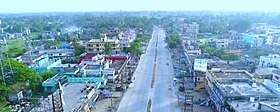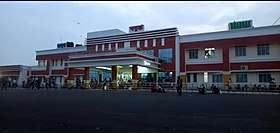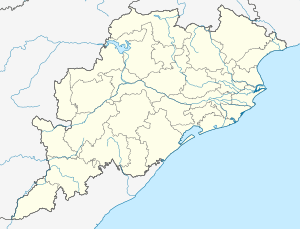Bhadrak
Bhadrak is a city of Odisha state in eastern India. It came into existence on 1 April 1993. The city is the district headquarters of Bhadrak district. According to legend, the city derives its name from the Goddess Bhadrakali, whose temple is on the banks of the Salandi River.[3]
Bhadrak | |
|---|---|
    From Top; Left to Right: Bhadrak City view, Dhamra Port, Akhandalamani Temple and Bhadrak Railway Station | |
 Bhadrak Location in Odisha, India  Bhadrak Bhadrak (India) | |
| Coordinates: 21.06°N 86.50°E | |
| Country | |
| State | |
| District | Bhadrak |
| Government | |
| • Type | Municipality |
| • Body | Bhadrak Municipality |
| Area | |
| • Total | 78.86 km2 (30.45 sq mi) |
| Elevation | 23 m (75 ft) |
| Population (2011)[2] | |
| • Total | 107,369 |
| • Density | 1,400/km2 (3,500/sq mi) |
| Demonym(s) | Bhadrakia |
| Languages | |
| • Official | Odia |
| Time zone | UTC+5:30 (IST) |
| PIN | 756100 |
| Website | bhadrak |
History
According to legend, Bhadrak derives its name from the Goddess Bhadrakali, whose temple is situated on the southwest outskirts of the town. It is an ancient land, dating from the age of the Puranas.[1]
Bhadrak's contribution to Odisha's maritime and agrarian prosperity, trade, and commerce throughout the ages is a part of history. In the Mughal period, Bhadrak was a subah, or province, under the Nawabs of Bengal. When the imperial power of the Mughals waned, the area consisted of principalities such as Kanika, Nampo, and Agarapada, with administrative sub-units called chowparhies, all ruled by Kshatriya chiefs.[1]
After the occupation of Odisha by the British in June 1804, Bhadrak constituted one of the two administrative divisions of Cuttack and Balasore. In 1828, when Balasore was made a separate district, Bhadrak became one of its sub-divisions with an assistant magistrate and deputy collector as the sub-divisional head; but the munsif's court remained in Jajpur until 1901.[1]
Bhadrak was at the forefront during the period of national struggle. In 1920, Mahatma Gandhi's non-cooperation movement was launched. In March 1921, Gandhi visited Bhadrak, after being impressed by its nationalistic fervor and fighting spirit. In 1922, he started the rebellion of Kanika which British troops stationed at Bhadrak attempted to suppress; but ultimately the tenants' movement triumphed, under the leadership of Chakradhar Behera, the doyen of Kanika.[1]
When the civil disobedience movement was launched in 1930, Bhadrak became ardent with patriotic zeal, the salt law was defied, and success achieved against the government. Harekrushna Mahatab's role in this success has become cherished in Bhadrak, and a part of the history of modern India. Gandhi, who visited Bhadrak again in 1934, staying in Mahatab's residence at Nuabazar, addressed a meeting of the Harizan workers in Jimbaran Ashram (Nuasahi, Ashram, Garadpur). It was during this time that Banchhanidhi Mohanty of Eram was by his patriotic songs shaping, stimulating, and sensitizing the national consciousness among the people.[1]
Since independence, the history of Bhadrak has been of progress in education, industry, agriculture, trade, and commerce.[1]
Climate
| Climate data for Bhadrak, Odisha | |||||||||||||
|---|---|---|---|---|---|---|---|---|---|---|---|---|---|
| Month | Jan | Feb | Mar | Apr | May | Jun | Jul | Aug | Sep | Oct | Nov | Dec | Year |
| Average high °C (°F) | 27.2 (81.0) |
30.0 (86.0) |
34.3 (93.7) |
36.9 (98.4) |
37.1 (98.8) |
34.6 (94.3) |
31.4 (88.5) |
31.3 (88.3) |
31.5 (88.7) |
30.5 (86.9) |
28.9 (84.0) |
27.0 (80.6) |
31.7 (89.1) |
| Average low °C (°F) | 14.4 (57.9) |
17.1 (62.8) |
21.4 (70.5) |
24.9 (76.8) |
26.7 (80.1) |
26.3 (79.3) |
25.7 (78.3) |
25.9 (78.6) |
25.6 (78.1) |
23.4 (74.1) |
18.0 (64.4) |
14.3 (57.7) |
22.0 (71.6) |
| Average rainfall mm (inches) | 13 (0.5) |
31 (1.2) |
34 (1.3) |
45 (1.8) |
85 (3.3) |
212 (8.3) |
306 (12.0) |
326 (12.8) |
273 (10.7) |
161 (6.3) |
38 (1.5) |
6 (0.2) |
1,530 (59.9) |
| Source: en.climate-data.org | |||||||||||||
Transportation
Bhadrak town is well connected with the state of Odisha, and to other parts of the country as well. The town lies on National Highway 16, 130 kilometres (81 mi) northeast of Bhubaneswar, the state capital.[4]
Bhadrak town has three bus stations, one on NH 16, the others near Bant Chhak and Charampa. There are frequent buses to and from Cuttack, Bhubaneswar, Balasore, and Calcutta.
Bhadrak railway station is at Charampa, which is 3 kilometres (1.9 mi) north of Bhadrak city.
The nearest airport is Biju Patnaik International Airport, 135 kilometres (84 mi) southwest, near Bhubaneswar.[4]
The nearest port is Dhamra Port, around 75 kilometers east of the town.
Demographics
As of 2011, Bhadrak has a population of 107,463. Males constitute 51% (55,090) of the population and females 49% (52,373). Bhadrak has an average literacy rate of 79.49%, higher than the national average of 59.5%; with 83.99% of males, and 74.77% of females, literate. 12% (13,138) of the population is under 6 years of age.[2]
Politics
Bhadrak is part of Lok Sabha Constituency 3 Bhadrak(SC).[5] The present Member of Parliament is Manjulata Mandal, of the Biju Janata Dal (BJD).[6]
The current MLA from the Bhadrak assembly constituency is Sanjib Mallick,[6] of the BJD, who won the seat in 2019. Previous MLAs from this seat were Jugal Kishore Pattnaik (BJD), who was the MLA for two terms up to 2019; Naren Palei, of the INC, elected in 2004; Biren Palei, INC, in 2000; Prafulla Samal (BJD), who won in 1995 and in 1990; Jugal Kishore Pattanayak, who won in 1985, as a member of the INC, and in 1980, as a member of INC(I); and Ratnakar Mohanty, of JNP, in 1977.
Education

The higher education institutions of the district are the Bhadrak Institute of Engineering and Technology (BIET) and Bhadrak Autonomous College,[7] among others. There are six new industrial training institutes (ITI) in Bhadrak, whose courses impart technical skill to students.
There are also numerous secondary schools. Bhadrak High School, established in 1882, is one of the oldest schools in Odisha. Dr. Harekrushna Mahatab, first chief minister of Odisha, studied at this school. Schools using English as a medium of instruction include Durga Prasad Saraf Vidyapeeth,[8] SBD International School, Happy Home School, Sunshine Mission School, Sathya Sai Vidya Vihar School, Carmel School, and St. Xavier's School.
Tourism and culture
_son_of_Kashi_Nath_Nayak.jpg)
The Akhandalamani Temple, the abode of Lord Siva is located on the bank of the Baitarani River, at Aradi, 37 kilometres (23 mi) from the district headquarters. On the outskirts of the city, 5 kilometres (3.1 mi) southwest, is situated Maa Bhadrakali Temple, whose deity, it is believed, gave the town its name.[9]
In the city itself one can worship and get blessing at Maa Banka Basuli Temple and Baba Lokanath Shiva Temple. Historical places and monuments to visit in the Bhadrak district include several Hindu temples; such as the Maa Santoshi Temple, located in Korkora village; Sri Radha Madanmohan temple; the temple of Akhandalamani; the Kali Puja held at Charampa; Prasanna Khemeswar Mahadev Temple in Anijo village, which is a Shiva temple that has existed for 150 years.[10]
There are also Muslim mosques such as the Sufi Saint Mujahid-e-Millat's Shrine (Mazaar) at Dhamnagar. This shrine is also known as Khanquah-E-Habibah. It is the center of an annual celebration called Eid-Miladun-Nabi.abinash, which commemorates the prophet Mohammad's birthday.
As a religious hub, Bhadrak is also home to festivals and religious celebrations. The "Pana Sankranti" held at Chhatrapati, 14 to 21 April, is one of the most famous. "Dola Purnima" or Holi (Melana) is also another major festival; it is celebrated in several locations in Bhadrak. The Cart Festival (Ratha Yatra), on the other hand, is celebrated in Jharpata, Gamal, Hide, Ghanteswar, Totapada, Chhatrapati, Bhadrak, and Bhatia village Sri Jagannath matha. This last location is one of the oldest places which observes Ganesh puja (150 years).
See also
References
- "About the District". Bhadrak district. 2007. Archived from the original on 21 October 2017. Retrieved 20 May 2018.
- "Bhadrak City Census 2011 data". Office of the Registrar General & Census Commissioner, India. Retrieved 20 May 2018.
- "About District". Bhadrak district. 2018. Retrieved 2 June 2018.
- "How to Reach". Bhadrak district. Retrieved 20 May 2018.
- "Assembly Constituencies - Corresponding Districts and Parliamentary Constituencies of Odisha" (PDF). Election Commission of India. Archived from the original (PDF) on 4 March 2009. Retrieved 2008-09-23.
- "Public Representatives". Bhadrak district. Retrieved 20 May 2018.
- "Bhadrak Autonomous College - ODISHA". bhadrakcollege.nic.in. Retrieved 11 June 2018.
- "Durga Prasad Saraf Vidyapeeth, Bhadrak". Dpsvidyapeeth.com. 2016. Archived from the original on 24 September 2016. Retrieved 20 May 2018.
- "Tourist Places". Government of Odisha: Bhadrak district. 2018. Retrieved 12 June 2018.
- "Culture & Heritage". Bhadrak district. Retrieved 21 May 2018.